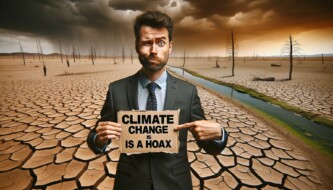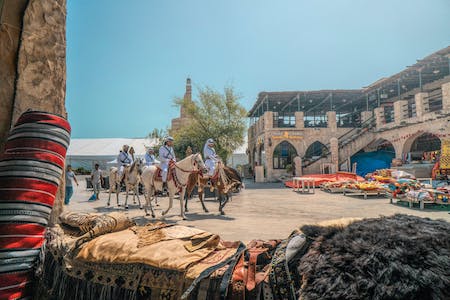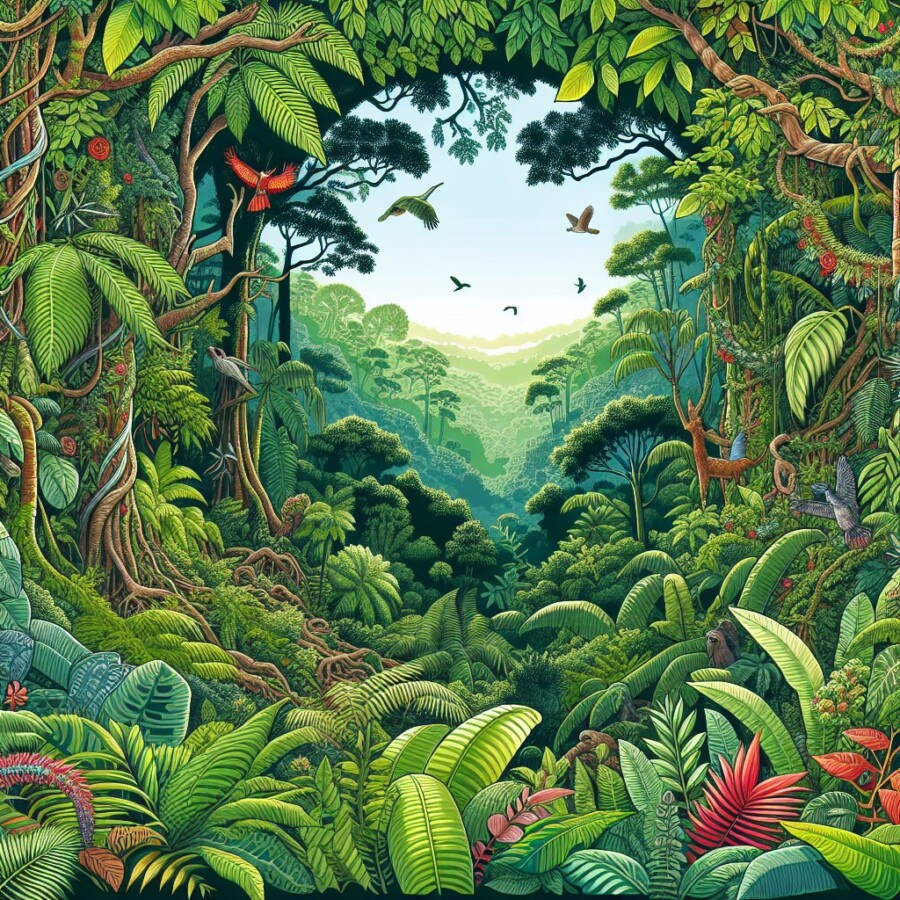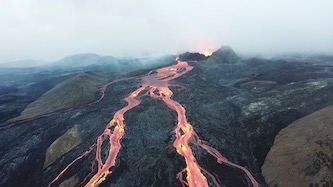Sarah Ott used to think that climate change was fake. She got this idea from her friends at church and a radio host who had conservative views. But now, she has changed her mind and is all about clean energy and teaching teenagers about climate change. It wasn’t easy for Sarah to make this change because she had to leave her old community and deal with people criticizing her. But she realized that the truth is important and she wanted to make a difference.
Sarah’s family background and her parents’ love for science made her care about nature and the environment. When she first heard about “climate change” as a kid, she didn’t think it would affect her. She went to college to study animals and became a science teacher, but she started believing that climate change was a hoax because of what she heard on conservative radio shows.
One thing that made Sarah change her mind was listening to a non-profit radio station that talked about climate change in a reasonable way. She started looking at other sources of information and realized that her friends and church group had different views. After the 2016 US presidential elections, she decided to leave her old group and went back to teaching. She made new friends who believed in the same things as her.
Now, Sarah volunteers with groups that want to find solutions to climate change and teaches her students about it. It was hard for her to admit that she was wrong, but she thinks it’s important to be a good example and to understand others who might be going through the same thing. She says that it’s important to connect with people by finding things you have in common and creating a supportive environment for them to change their minds.
New research shows that in the US, people are becoming more divided when it comes to climate change. But there is also evidence that people are changing their minds. Sarah’s story shows that education and being open to new ideas can help us deal with climate change skepticism.
Original news source: I thought climate change was a hoax. Now I’ve changed my mind’ (BBC)
Listen
Slow
Normal
Fast
Group or Classroom Activities
Warm-up Activities:
– News Summary
Instructions: Divide the class into small groups. Provide each group with a copy of the article. Instruct them to read the article and then summarize the main points in a paragraph or two. After a designated amount of time, have each group share their summaries with the rest of the class.
– Opinion Poll
Instructions: Create a list of statements related to climate change beliefs (e.g. “Climate change is a hoax,” “Climate change is caused by human activity,” “Climate change is a natural occurrence,” etc.). Have the students stand on opposite sides of the room, representing a spectrum of agreement or disagreement with each statement. Read out each statement and ask the students to move to the position that best represents their opinion. After each statement, give the students an opportunity to discuss their opinions with others who are standing in the same position.
– Vocabulary Pictionary
Instructions: Create a list of key vocabulary words from the article (e.g. climate change, skepticism, conservative, non-profit, etc.). Divide the class into small groups. Give each group a set of vocabulary words. Instruct the groups to take turns selecting a word and drawing a picture to represent it. The other groups must guess the word based on the picture. The group that guesses correctly earns a point. The group with the most points at the end of the game wins.
– Pros and Cons
Instructions: Divide the class into pairs or small groups. Instruct each group to make a list of the pros and cons of climate change skepticism. After a designated amount of time, have each group share their lists with the rest of the class. Encourage a respectful discussion and debate about the different perspectives.
– Future Predictions
Instructions: Instruct the students to imagine themselves in the year 2050. Ask them to write a short paragraph or create a visual representation of what they think the world will look like in terms of climate change. Encourage them to consider both positive and negative outcomes. After a designated amount of time, have the students share their predictions with the class and discuss their reasoning behind their predictions.
Comprehension Questions:
1. Why did Sarah Ott used to think climate change was fake?
2. What made Sarah change her mind about climate change?
3. How did Sarah’s family background influence her care for nature and the environment?
4. What sources of information did Sarah start looking at to learn more about climate change?
5. Why did Sarah decide to leave her old group after the 2016 US presidential elections?
6. What does Sarah do now to help find solutions to climate change?
7. Why was it hard for Sarah to admit that she was wrong about climate change?
8. What does Sarah believe is important when trying to change someone’s mind about climate change?
Go to answers ⇩
Listen and Fill in the Gaps:
Sarah Ott used to think that (1)______ change was fake. She got this idea from her friends at church and a radio host who had conservative views. But now, she has changed her mind and is all about clean energy and teaching teenagers about climate change. It wasn’t easy for Sarah to make this change because she had to (2)______ her old community and deal with people (3)______ her. But she realized that the truth is important and she wanted to make a difference.
Sarah’s (4)______ background and her parents’ love for science made her care about nature and the (5)______. When she first heard about “climate (6)______” as a kid, she didn’t (7)______ it would affect her. She went to college to study animals and became a science teacher, but she started (8)______ that climate change was a hoax because of what she heard on conservative radio shows.
One thing that made Sarah change her mind was listening to a non-profit radio station that talked about climate change in a reasonable way. She started looking at other sources of information and realized that her friends and church (9)______ had different views. After the 2016 US presidential elections, she decided to leave her old group and went back to teaching. She made new friends who believed in the same things as her.
Now, Sarah volunteers with groups that want to find solutions to climate change and (10)______ her (11)______ about it. It was hard for her to admit that she was wrong, but she (12)______ it’s important to be a good example and to understand (13)______ who might be going through the same thing. She says that it’s important to connect with people by finding things you have in common and (14)______ a supportive environment for them to change their (15)______.
New research shows that in the US, people are becoming more divided when it comes to climate change. But there is also evidence that people are changing their minds. Sarah’s (16)______ shows that education and being open to new ideas can help us deal with climate change skepticism.
Go to answers ⇩
Discussion Questions:
Students can ask a partner these questions, or discuss them as a group.
1. What is climate change and why is it important?
2. How would you feel if your friends and family didn’t believe in climate change?
3. Do you think it’s easy or difficult to change your mind about something you strongly believe in? Why or why not?
4. What do you think are some reasons why people might be skeptical about climate change?
5. How do you think Sarah felt when she realized she had been wrong about climate change?
6. Do you think it’s important for people to admit when they are wrong? Why or why not?
7. What are some ways that Sarah is making a difference in the fight against climate change?
8. How do you think Sarah’s background and parents’ love for science influenced her beliefs about climate change?
9. Do you think it’s important to listen to different perspectives and sources of information? Why or why not?
10. How can education and being open to new ideas help us address climate change skepticism?
11. What are some ways that you can connect with people who have different opinions about climate change?
12. How do you think Sarah’s new friends supported her in changing her mind about climate change?
13. What are some challenges that Sarah faced when she decided to change her beliefs about climate change?
14. Do you think it’s important for young people to be involved in finding solutions to climate change? Why or why not?
15. How can we encourage more people to be open to changing their minds about climate change?
Individual Activities
Vocabulary Meanings:
Match each word to its meaning.
Words:
1. climate change
2. conservative
3. community
4. criticize
5. environment
6. information
7. example
8. divided
Meanings:
(a) Someone who has traditional views and is resistant to change
(b) The natural world and the surroundings in which we live
(c) To express disapproval or negative opinions about someone or something
(d) The change in weather patterns caused by humans
(e) Split or separated into different groups or opinions
(f) A person or thing that is seen as a model to follow
(g) A group of people who live in the same area
(h) Facts or details about a subject
Go to answers ⇩
Multiple Choice Questions:
1. What made Sarah Ott change her mind about climate change?
(a) Her friends at church and a conservative radio host.
(b) Listening to a non-profit radio station and looking at other sources of information.
(c) Her love for science and studying animals.
(d) The 2016 US presidential elections.
2. What did Sarah have to deal with when she changed her mind about climate change?
(a) Finding new friends who believed in the same things as her.
(b) People criticizing her.
(c) Leaving her old community.
(d) All of the above.
3. Why did Sarah decide to leave her old group after the 2016 US presidential elections?
(a) She wanted to find new friends who believed in the same things as her.
(b) She wanted to make a difference by teaching about climate change.
(c) All of the above.
(d) She realized they had different views on climate change.
4. What does Sarah do now to help with climate change?
(a) She teaches her students about climate change.
(b) She tries to connect with people and create a supportive environment for them to change their minds.
(c) She volunteers with groups that want to find solutions.
(d) All of the above.
5. What does Sarah think is important when trying to change someone’s mind about climate change?
(a) Being a good example.
(b) Understanding others who might be going through the same thing.
(c) All of the above.
(d) Connecting with people by finding things you have in common.
6. What does the new research show about people in the US and climate change?
(a) People are becoming more divided.
(b) People are changing their minds.
(c) People are becoming more divided and changing their minds.
(d) None of the above.
7. What does Sarah’s story show about dealing with climate change skepticism?
(a) Finding common ground with others is important.
(b) Creating a supportive environment can make a difference.
(c) Education and being open to new ideas can help.
(d) All of the above.
8. How did Sarah’s parents influence her care for nature and the environment?
(a) They loved science.
(b) They taught her about climate change.
(c) They wanted her to study animals.
(d) They didn’t influence her care for nature and the environment.
Go to answers ⇩
True or False Questions:
1. Sarah changed her mind about climate change after listening to a non-profit radio station that discussed it in a reasonable way.
2. Sarah initially didn’t think climate change would affect her personally when she first heard about it as a kid.
3. Sarah now volunteers with groups that are working to find solutions to climate change and teaches her students about it.
4. Sarah decided to stay in her old community and make new friends who believed in different things than her after the 2016 US presidential elections.
5. Sarah’s family background and her parents’ love for science made her indifferent about nature and the environment.
6. Sarah believes it’s important to connect with people by finding disagreements and creating a challenging environment for them to change their minds.
7. Sarah used to believe that climate change was fake because of what she heard from her friends at church and a conservative radio host.
8. Sarah became a science teacher but started doubting climate change was a hoax due to conservative radio shows.
Go to answers ⇩
Write a Summary:
Write a summary of this news article in two sentences.
Check your writing now with the best free AI for English writing!
Writing Questions:
Answer the following questions. Write as much as you can for each answer.
Check your answers with our free English writing assistant!
1. What made Sarah change her mind about climate change?
2. How did Sarah’s family background influence her views on the environment?
3. Why did Sarah decide to leave her old community?
4. What does Sarah do now to help combat climate change?
5. According to the article, what can help people overcome climate change skepticism?
Answers
Comprehension Question Answers:
1. Why did Sarah Ott used to think climate change was fake?
Sarah used to think climate change was fake because her friends at church and a conservative radio host had convinced her that it was a hoax.
2. What made Sarah change her mind about climate change?
Sarah changed her mind about climate change after listening to a non-profit radio station that talked about it in a reasonable way. She also started looking at other sources of information and realized that her friends and church group had different views.
3. How did Sarah’s family background influence her care for nature and the environment?
Sarah’s family background and her parents’ love for science made her care about nature and the environment. They taught her to appreciate and respect the natural world.
4. What sources of information did Sarah start looking at to learn more about climate change?
Sarah started looking at a non-profit radio station and other sources of information to learn more about climate change.
5. Why did Sarah decide to leave her old group after the 2016 US presidential elections?
After the 2016 US presidential elections, Sarah decided to leave her old group because she realized that their beliefs and values were different from hers. She wanted to surround herself with people who shared her passion for addressing climate change.
6. What does Sarah do now to help find solutions to climate change?
Sarah volunteers with groups that are working to find solutions to climate change. She also teaches her students about climate change and its impact on the environment.
7. Why was it hard for Sarah to admit that she was wrong about climate change?
It was hard for Sarah to admit that she was wrong about climate change because she had to leave her old community and deal with criticism from people who disagreed with her. It can be challenging to change one’s beliefs and face judgment from others.
8. What does Sarah believe is important when trying to change someone’s mind about climate change?
Sarah believes that it is important to connect with people by finding common ground and creating a supportive environment for them to change their minds. She understands that changing one’s beliefs can be difficult, and it requires patience, understanding, and open-mindedness.
Go back to questions ⇧
Listen and Fill in the Gaps Answers:
(1) climate
(2) leave
(3) criticizing
(4) family
(5) environment
(6) change
(7) think
(8) believing
(9) group
(10) teaches
(11) students
(12) thinks
(13) others
(14) creating
(15) minds
(16) story
Go back to questions ⇧
Vocabulary Meanings Answers:
1. climate change
Answer: (d) The change in weather patterns caused by humans
2. conservative
Answer: (a) Someone who has traditional views and is resistant to change
3. community
Answer: (g) A group of people who live in the same area
4. criticize
Answer: (c) To express disapproval or negative opinions about someone or something
5. environment
Answer: (b) The natural world and the surroundings in which we live
6. information
Answer: (h) Facts or details about a subject
7. example
Answer: (f) A person or thing that is seen as a model to follow
8. divided
Answer: (e) Split or separated into different groups or opinions
Go back to questions ⇧
Multiple Choice Answers:
1. What made Sarah Ott change her mind about climate change?
Answer: (b) Listening to a non-profit radio station and looking at other sources of information.
2. What did Sarah have to deal with when she changed her mind about climate change?
Answer: (b) People criticizing her.
3. Why did Sarah decide to leave her old group after the 2016 US presidential elections?
Answer: (d) She realized they had different views on climate change.
4. What does Sarah do now to help with climate change?
Answer: (c) She volunteers with groups that want to find solutions.
5. What does Sarah think is important when trying to change someone’s mind about climate change?
Answer: (d) Connecting with people by finding things you have in common.
6. What does the new research show about people in the US and climate change?
Answer: (a) People are becoming more divided.
7. What does Sarah’s story show about dealing with climate change skepticism?
Answer: (c) Education and being open to new ideas can help.
8. How did Sarah’s parents influence her care for nature and the environment?
Answer: (a) They loved science.
Go back to questions ⇧
True or False Answers:
1. Sarah changed her mind about climate change after listening to a non-profit radio station that discussed it in a reasonable way. (Answer: True)
2. Sarah initially didn’t think climate change would affect her personally when she first heard about it as a kid. (Answer: True)
3. Sarah now volunteers with groups that are working to find solutions to climate change and teaches her students about it. (Answer: True)
4. Sarah decided to stay in her old community and make new friends who believed in different things than her after the 2016 US presidential elections. (Answer: False)
5. Sarah’s family background and her parents’ love for science made her indifferent about nature and the environment. (Answer: False)
6. Sarah believes it’s important to connect with people by finding disagreements and creating a challenging environment for them to change their minds. (Answer: False)
7. Sarah used to believe that climate change was fake because of what she heard from her friends at church and a conservative radio host. (Answer: True)
8. Sarah became a science teacher but started doubting climate change was a hoax due to conservative radio shows. (Answer: False)
Go back to questions ⇧













